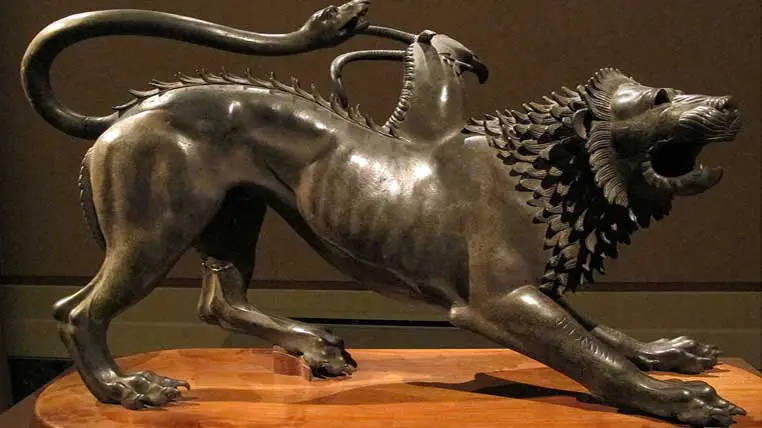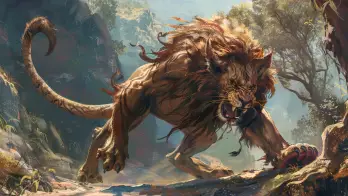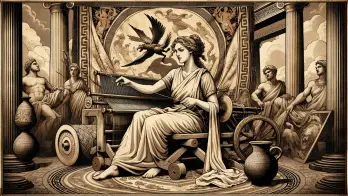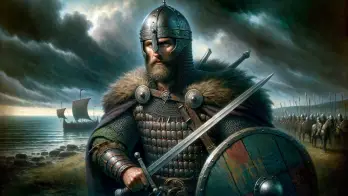Chimera, one of the terrifying descendants of Typhon and Echidna, was a hybrid monster that combined physical features from three animals: lion, goat, and serpent (or dragon).
According to Greek myths, Chimera was sent by the gods to terrorize the inhabitants at the foot of the Lycian Mountains after they refused to honor the Olympians properly.
The creature killed hundreds of locals before being slain by the hero Bellerophon, aided by the winged horse Pegasus.
Throughout the centuries, Chimera has inspired fear and fascination, with its image being used in literature, art, and popular culture.
Who was Chimera in Greek mythology?
Chimera was a hybrid monster with the head of a lion, the body of a goat, and the tail of a serpent.
The earliest description of the creature comes from the “Iliad,” where Homer describes the creature as “a lion in front, in the rear a serpent, and in the middle a goat, breathing fierce fire.”
According to Greek mythology, Chimera lived in the Lycian Mountains, an ancient kingdom on the southwest coast of modern-day Turkey. However, the geographer Strabo placed the legendary creature in an even more specific location: Mount Cragus on the Lycian coast.
In Virgil’s “Aeneid,” after the hero Bellerophon slew it, Chimera made its lair at the gates of the underworld kingdom of Hades, where it was in the company of many other mythical monsters killed by gods, demigods, or ordinary mortals.
Chimera has been a popular figure in literature and art throughout the centuries.
In Virgil’s “Aeneid,” the offspring of Typhon and Echidna is described as a “creature with three heads” that was defeated by the hero Aeneas (not Bellerophon, as in most ancient myths).
In Ovid’s “Metamorphoses,” however, the monster is depicted as having a lion’s head, a goat’s body, and a dragon’s tail.
In art, Chimera has been portrayed in various forms, from ancient Greek vases to Renaissance paintings, symbolizing danger and chaos. For the artists of ancient times, it represented the dangers of unchecked ambition and pride.
Etymology
The name “Chimera” comes from the Greek word “chimaira,” meaning “animal of one year” or, according to other translations, “goat.”
The etymology of the name can also be related to other linguistic sources, such as “gymbr” (meaning “young sheep”), or can be associated with the Greek terms “cheimōn” and “cheima” and the Indo-European root “ǵh-ei-m-,” meaning “winter.”
Genealogy
Parents
- Typhon: In Greek mythology, Typhon was a monstrous creature, the son of Gaia (Earth) and Tartarus (Underworld). He was described as a giant with a hundred heads, serpent legs, and wings that caused storms and earthquakes.
- Echidna: Echidna was a half-woman, half-snake creature, and the mate of Typhon. She was also known as the “Mother of All Monsters” in Greek mythology.
Siblings
- Orthos: Orthos was a two-headed dog, brother of Cerberus, and offspring of Typhon and Echidna.
- Hydra: Hydra was a monstrous serpent with multiple heads, born to Typhon and Echidna. It was known for its ability to regrow its heads, making it nearly impossible to kill.
- Cerberus: Cerberus was a three-headed dog born to Typhon and Echidna. He was the guardian of the entrance to the Underworld in Greek mythology.
Spouse
- Orthos
Children
- The Sphinx: The Sphinx was a mythical creature with the head of a human and the body of a lion, known for guarding the entrance to the city of Thebes in Greek mythology.
- The Nemean Lion: The Nemean Lion was a monstrous creature with impenetrable skin that was killed by Heracles as one of his Twelve Labors in Greek mythology.
Chimera was a hybrid monster with a lion’s head, a goat’s body, and a dragon’s tail that spits fire. She was born from the union of Typhon and Echidna; her mother, a sister to the Gorgons, is a monster born from the earth’s bowels.
According to the poet Hesiod, Chimera had three siblings: Orthos (the two-headed watchdog of the giant Geryon), Hydra (a many-headed serpent), and Cerberus (the three-headed dog, guardian of Hades’ underworld).
Chimera and Orthos gave birth to the Nemean Lion and the Sphinx.
Myths and legends
The origins of Chimera are obscure. According to Homer’s “Iliad,” the creature was “raised” by a certain Amisodar to be “a bane to many men.” Beyond this detail, the monster appears only in the mythology of Bellerophon.
In common tradition, Bellerophon provoked the unjust wrath of Proetus, the king of Argos (who wrongly believed that the hero had seduced his wife).
Thus, the king devised a plan to kill Bellerophon without performing the deed himself. He summoned the hero and handed him a letter for his good friend, Iobates, the king of Lycia.
Unknowingly, Bellerophon was delivering a letter with instructions to kill its bearer immediately.
But Iobates hesitated to carry out what Proetus asked of him. Therefore, he came up with the idea of sending Bellerophon to fight Chimera, which was terrorizing the villages and towns in the region, expecting the monster to quickly slay the hero.
However, Bellerophon, who was a son of the sea god Poseidon, had the favor of the gods.
Looking down from on high, riding the winged horse Pegasus, like Zeus, Bellerophon spotted Chimera traversing Iobates’ kingdom – leaving scorched earth in her wake.
Without much hesitation, the hero fired an arrow at the monster. Chimera roared and opened her hungry mouths, spitting fire.
A fierce battle ensued.
Bellerophon aimed at the beast’s ribs, heads, or scaly tail from the high heavens. But Typhon’s offspring was deceitful. She looked like a goat, leaping nimbly, or crawled on the ground with her dragon’s body, and when you least expected it, roared like a lioness.
And flames erupted, in waves, up to the sky, almost devouring Bellerophon.
And perhaps, in the end, Chimera would have overcome the young man. However, Belerofon, taught by Athena, had three lead spikes at his belt.
Seeing that the beast was becoming more and more ferocious, the hero threw the lead spikes into its open mouths, and they melted under the creature’s fiery breath.
The lead seeped deeply into its entrails, and the offspring of Typhon, which had terrified the world, fell to the ground, spreading poisonous fumes around it.
Symbolism
Chimera was defeated by Bellerophon, the hero assimilated with lightning, riding on the winged horse, Pegasus. Their battle appears in many works of art and on numerous coins, especially Corinthian ones.
All these elements suggest that we are dealing with an extremely complex symbol in imaginary creations born from the depths of the unconscious and perhaps represent the desires that frustrations exacerbate and transform into a source of pain.
Chimera seduces and leads to ruin whoever is drawn to it. The beast cannot be confronted head-on but must be pursued and attacked by surprise, even in its deepest lairs.
Initially, sociologists and poets saw in it only the image of torrents, capricious like goats, devastating like lions, sinuous like snakes, and which cannot be stopped but must be tamed by indirect means – drying up their course.
According to Paul Diel’s interpretation, Chimera is a psychic deformation characterized by a fertile and uncontrolled imagination expressing the danger of imaginative exaltation.
Its snake or dragon tail corresponds to spiritual perversion through vanity; its goat body, to perverse and capricious sexuality; its lion’s head, to a dominant tendency that destroys any social relationship.
This complex symbol finds its embodiment in both a monster that devastates a region and in the disastrous reign of a perverted, tyrannical, or weak sovereign.
Questions and answers about Chimera
What is Chimera in Greek mythology?
Chimera is a monstrous creature from Greek mythology with the head of a lion, a goat’s body, and a serpent’s tail. It is also depicted with wings and sometimes with additional heads or limbs.
What is the origin of the Chimera myth?
The Chimera myth originated in ancient Greek mythology, with the creature appearing in various works of literature and art.
Its first recorded appearance is in the “Iliad,” where it is described as a fire-breathing monster that terrorizes the Lycian countryside.
What was the role of the Chimera in Greek mythology?
In Greek mythology, the monster was a symbol of chaos and destruction. It was often portrayed as a monster that could not be defeated, and many heroes attempted to slay it in vain.
The creature was also seen as a manifestation of the darker aspects of human nature, such as greed and violence.
What was the weakness of Chimera?
According to the myth, the Chimera’s weakness was its own breath. It breathed fire, but its breath was so hot that it would melt its own body. This allowed the hero Bellerophon to defeat it using a lead-tipped spear to smother its fire breath.
What is the story of Bellerophon and Chimera?
Bellerophon was a hero who was tasked with slaying Chimera. He was given a lead-tipped spear by the goddess Athena, and he used it to defeat the creature by smothering its fire breath.
Bellerophon then went on to perform other heroic deeds, but he eventually fell from grace and suffered a tragic end.
What is the symbolism of Chimera in art?
In art, Chimera has been used as a symbol of the darker aspects of human nature, such as greed and violence. It has also been used as a symbol of chaos and destruction and a symbol of the creative imagination.
What is the etymology of the name “Chimera”?
The name “Chimera” comes from the Greek word “khimaira,” which means “she-goat.” The creature’s goat-like body is thought to be the inspiration for its name.
What other mythical creatures are related to Chimera?
Chimera is often associated with other mythical creatures, like the Hydra and Cerberus. These creatures are also depicted as multi-headed monsters and are often portrayed as similarly challenging to defeat.
At Ancient Theory we only use trusted sources to document our articles. Such relevant sources include authentic documents, newspaper and magazine articles, established authors, or reputable websites.
- R. L. Fowler - Early Greek Mythography: Text and Introduction. Oxford University Press, 2000.
- Chimera (mythology). wikipedia.org. [Source]
- Karl Schefold - Myth and Legend in Early Greek Art. Thames and Hudson, Londra, 1966.
- Hesiod, translated by M. L. West - Theogony. Oxford University Press, 1996.
- Ovid, translated by Charles Martin - Metamorphoses. W. W. Norton & Company, 2004.
- Robert Graves - The Greek Myths. Penguin Books, 1960.
- Karl Kerényi - The Gods of the Greeks. Thames and Hudson, 1951.
- Apollodorus, translated by Sir James George Frazer - The Library of Greek Mythology. Oxford University Press, 1921.
- Chimera. britannica.com. [Source]
- Edith Hamilton - Mythology. Grand Central Publishing, 2011.
- Walter Burkert - Greek Religion. Harvard University Press, 1985.
- Jan Bremmer - Greek Religion and Culture, the Bible and the Ancient Near East. Brill, 2008.
- Richard Buxton - Imaginary Greece: The Contexts of Mythology. Cambridge University Press, 1994.
- Jane Ellen Harrison - Prolegomena to the Study of Greek Religion. Princeton University Press, 1991.







